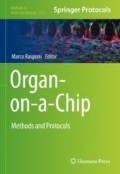Abstract
Modeling human cardiac tissues in vitro is essential to elucidate the biological mechanisms related to the heart physiopathology, possibly paving the way for new treatments. Organs-on-chips have emerged as innovative tools able to recreate tissue-specific microenvironments, guiding the development of miniaturized models and offering the opportunity to directly analyze functional readouts. Here we describe the fabrication and operational procedures for the development of a heart-on-chip model, reproducing cardiac biomimetic microenvironment. The device provides 3D cardiac microtissue with a synchronized electromechanical stimulation to support the tissue development. We additionally describe procedures for characterizing tissue evolution and functionality through immunofluorescence, real time qPCR, calcium imaging and microtissue contractility investigations.
Access this chapter
Tax calculation will be finalised at checkout
Purchases are for personal use only
References
Chiong M et al (2011) Cardiomyocyte death: mechanisms and translational implications. Cell Death Dis 2(12):e244. https://doi.org/10.1038/cddis.2011.130
Vunjak Novakovic G, Eschenhagen T, Mummery C (2014) Myocardial tissue engineering: in vitro models. Cold Spring Harb Perspect Med 4(3):a014076. https://doi.org/10.1101/cshperspect.a014076
Mathur A, Ma Z, Loskill P, Jeeawoody S, Healy KE (2016) In vitro cardiac tissue models: current status and future prospects. Adv Drug Deliv Rev 96:203–213. https://doi.org/10.1016/j.addr.2015.09.011
Ferrari E, Palma C, Vesentini S, Occhetta P, Rasponi M (2020) Integrating biosensors in organs-on-chip devices: a perspective on current strategies to monitor microphysiological systems. Biosensors 10(9):110. https://doi.org/10.3390/bios10090110
Bhatia SN, Ingber DE (2014) Microfluidic organs-on-chips. Nat Biotechnol 32:760–772
Gupta K et al (2010) Lab-on-a-chip devices as an emerging platform for stem cell biology. Lab Chip 10:2019
Ugolini GS, Cruz-Moreira D, Visone R, Redaelli A, Rasponi M (2016) Microfabricated physiological models for in vitro drug screening applications. Micromachines 7(12):233. https://doi.org/10.3390/mi7120233
Whitesides GM (2006) The origins and the future of microfluidics. Nature 442:368–373
Griffith LG, Swartz MA (2006) Capturing complex 3D tissue physiology in vitro. Nat Rev Mol Cell Biol 7:211–224
Folkman J, Greenspan HP (1975) Influence of geometry on control of cell growth. Biochim Biophys Acta 417:211–236
Sniadecki NJ, Desai RA, Ruiz SA, Chen CS (2006) Nanotechnology for cell-substrate interactions. Ann Biomed Eng 34:59–74
Hamon M, Hong JW (2013) New tools and new biology: recent miniaturized systems for molecular and cellular biology. Mol Cells 36(6):485–506. https://doi.org/10.1007/s10059-013-0333-1
McDonald JC, Whitesides GM (2002) Poly(dimethylsiloxane) as a material for fabricating microfluidic devices. Acc Chem Res 35(7):491–499. https://doi.org/10.1021/ar010110q
Occhetta P et al (2019) Hyperphysiological compression of articular cartilage induces an osteoarthritic phenotype in a cartilage-on-a-chip model. Nat Biomed Eng 3(7):545–557. https://doi.org/10.1038/s41551-019-0406-3
Huh D et al (2010) Reconstituting organ-level lung functions on a chip. Science 328:1662–1668
Pavesi A et al (2015) Controlled electromechanical cell stimulation on-a-chip. Sci Rep 5
Marsano A et al (2016) Beating heart on a chip: a novel microfluidic platform to generate functional 3D cardiac microtissues. Lab Chip 16:599–610
Grosberg A, Alford PW, McCain ML, Parker KK (2011) Ensembles of engineered cardiac tissues for physiological and pharmacological study: heart on a chip. Lab Chip 11:4165
Boudou T et al (2012) A microfabricated platform to measure and manipulate the mechanics of engineered cardiac microtissues. Tissue Eng Part A 18:910–919
Mathur A et al (2015) Human iPSC-based cardiac microphysiological system for drug screening applications. Sci Rep 5
Stoppel WL, Kaplan DL, Black LD (2016) Electrical and mechanical stimulation of cardiac cells and tissue constructs. Adv Drug Deliv Rev 96:135–155
Nitsan I, Drori S, Lewis YE, Cohen S, Tzlil S (2016) Mechanical communication in cardiac cell synchronized beating. Nat Phys 12
Ruwhof C, van der Laarse A (2000) Mechanical stress-induced cardiac hypertrophy: mechanisms and signal transduction pathways. Cardiovasc Res 47:23–37
Salameh A et al (2010) Cyclic mechanical stretch induces cardiomyocyte orientation and polarization of the gap junction protein connexin43. Circ Res 106:1592–1602
Dhein S et al (2014) Mechanical control of cell biology. Effects of cyclic mechanical stretch on cardiomyocyte cellular organization. Prog Biophys Mol Biol 115:93–102
Mangoni ME et al (2003) Functional role of L-type Cav1.3 Ca2+ channels in cardiac pacemaker activity. Proc Natl Acad Sci U S A 100:5543–5548
Fahrenbach JP, Mejia-Alvarez R, Banach K (2007) The relevance of non-excitable cells for cardiac pacemaker function. J Physiol 585:565–578
Cimetta E, Godier-Furnémont A, Vunjak-Novakovic G (2013) Bioengineering heart tissue for in vitro testing. Curr Opin Biotechnol 24:926–932
Visone R et al (2018) A microscale biomimetic platform for generation and electromechanical stimulation of 3D cardiac microtissues. APL Bioeng 2(4):046102. https://doi.org/10.1063/1.5037968
Acknowledgments
The silicon master mold fabrication was performed at PoliFAB, the micro- and nanofabrication facility of Politecnico di Milano. We thank Dr. Barbara Bettegazzi for the kind provision of rat cardiac hearts.
This project has received funding from the European Union’s Horizon 2020 research and innovation programme under the Marie Sklodowska-Curie grant agreement No 841975.
Author information
Authors and Affiliations
Corresponding author
Editor information
Editors and Affiliations
Rights and permissions
Copyright information
© 2022 Springer Science+Business Media, LLC, part of Springer Nature
About this protocol
Cite this protocol
Visone, R., Occhetta, P., Rasponi, M. (2022). Electromechanical Stimulation of 3D Cardiac Microtissues in a Heart-on-Chip Model. In: Rasponi, M. (eds) Organ-on-a-Chip. Methods in Molecular Biology, vol 2373. Humana, New York, NY. https://doi.org/10.1007/978-1-0716-1693-2_9
Download citation
DOI: https://doi.org/10.1007/978-1-0716-1693-2_9
Published:
Publisher Name: Humana, New York, NY
Print ISBN: 978-1-0716-1692-5
Online ISBN: 978-1-0716-1693-2
eBook Packages: Springer Protocols

